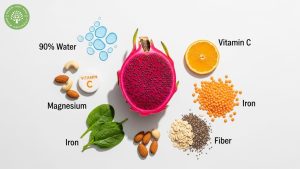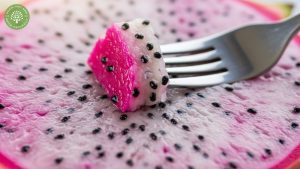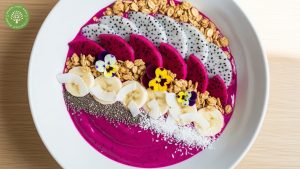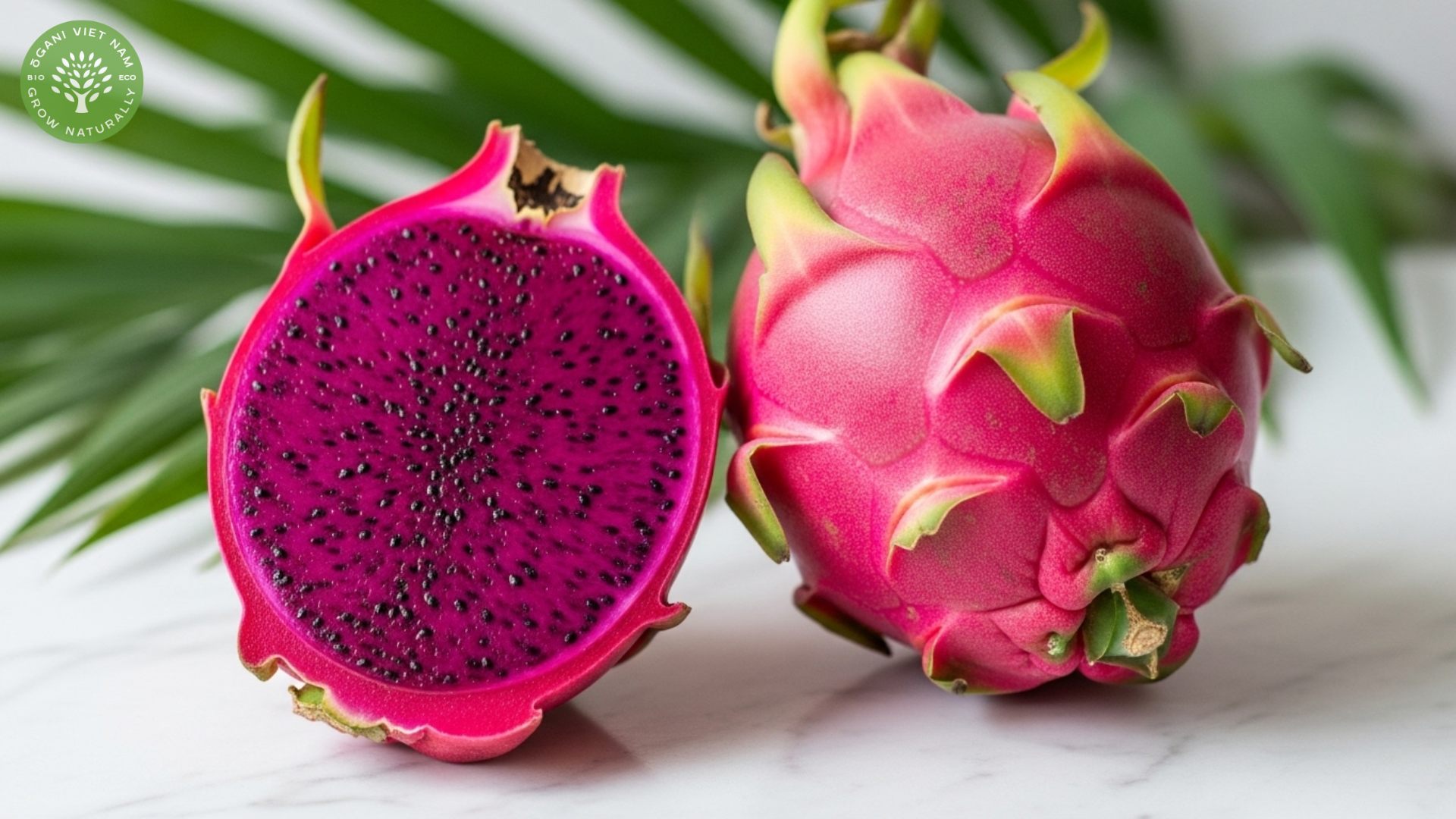Pink pitaya, also known as red dragon fruit, is a stunning tropical superfood with bright fuchsia skin and either white or magenta flesh speckled with tiny black seeds. At Ogani VN, we’ve watched this exotic fruit transform from an Instagram novelty into a legitimate nutritional powerhouse that deserves a place in your kitchen—and we’re here to tell you everything you need to know about it.
Unlike its plain-Jane cousin (the white-fleshed variety), pink pitaya brings both visual drama and a slightly sweeter flavor profile to your plate. Whether you’re eyeing that gorgeous powder on the grocery shelf or considering the fresh fruit at your local market, understanding what makes pink pitaya special will help you make the most of this remarkable ingredient.
What exactly is pink pitaya?
Pink pitaya comes from several species of cactus, primarily Hylocereus undatus, though the deep magenta-fleshed variety often comes from Hylocereus costaricensis. The fruit grows on climbing cacti that bloom at night—quite the dramatic origin story for something you’ll probably toss into your morning smoothie.
Here’s where things get interesting: when most people say “pink pitaya,” they could mean two different things. There’s the pink-skinned fruit with white flesh (the most common dragon fruit you’ll find), and then there’s the pink-skinned variety with vibrant pink or magenta flesh throughout. That second type? That’s the one with higher antioxidant levels and a sweeter taste that borders on berry-like.
The fruit itself weighs anywhere from 150 to 600 grams, with that iconic bright pink exterior covered in green-tipped scales that give it the “dragon” moniker. Slice one open, and you’ll find flesh so beautiful it almost doesn’t seem real—which is exactly why it’s become a social media darling and a favorite natural food coloring.
Pink pitaya nutritional benefits you need to know

Let’s cut through the superfood hype and talk real numbers. Pink pitaya is about 90% water, which makes it incredibly hydrating—think of it as nature’s sports drink with benefits. A 100-gram serving contains roughly 60 calories, 1.2 grams of protein, and virtually no fat.
But here’s what we really care about at Ogani VN:
- Vitamin C: A single serving gives you about 9-10% of your daily needs, supporting immune function and skin health
- Magnesium: Essential for muscle function and bone health
- Iron: Important for oxygen transport in your blood
- Fiber: Around 3 grams per serving, supporting digestive health
The magenta-fleshed varieties contain betalains—the same antioxidant compounds found in beets—which give the fruit its intense color and potential anti-inflammatory properties. These compounds are one reason why the pink-fleshed version commands a premium price compared to the white variety.
What’s perhaps most impressive is what pink pitaya doesn’t contain: virtually no fat, minimal sodium, and a low glycemic index that won’t spike your blood sugar. For anyone watching their calorie intake while still wanting nutrient density, this fruit checks the boxes without the guilt.
How pink pitaya actually tastes (and why some people are disappointed)

We need to have an honest conversation about flavor expectations. If you’re anticipating something as intensely flavored as its vibrant color suggests, you might be in for a surprise—and not necessarily the good kind.
The fresh fruit experience
Fresh pink pitaya with white flesh has a subtle, mildly sweet flavor that some describe as a cross between a kiwi and a pear, while others less charitably compare it to flavored water or even cucumber. The texture is what carries the experience: crisp, crunchy from those little black seeds (which are edible and add a pleasant textness), and refreshingly juicy.
The magenta-fleshed variety offers noticeably more sweetness with berry-like undertones. It’s still not an explosion of flavor like a mango or pineapple, but it’s definitely more interesting on your palate. Think of it as the difference between eating white bread and whole wheat—one’s just got more going on.
The powder perspective
Pink pitaya powder concentrates the fruit’s natural sugars and nutrients, giving you a more pronounced flavor that works beautifully in smoothies, yogurt bowls, and baked goods. At Ogani VN, we’ve found that the powder form is actually where this ingredient shines—you get that stunning pink color as a natural food dye plus enough flavor to matter, without the sometimes-watery disappointment of fresh fruit that wasn’t perfectly ripe.
The real magic happens when you combine pink pitaya with other ingredients. It plays exceptionally well with coconut, banana, mango, and berries, creating smoothie bowls that taste as good as they look on Instagram.
Practical ways to use pink pitaya in your kitchen

The beauty of this fruit—whether fresh, frozen, or powdered—is its versatility. You’re not limited to those trendy smoothie bowls, though we’ll admit they’re gorgeous.
Fresh fruit applications
Scoop the flesh straight from the skin with a spoon for the simplest approach. Cube it for fruit salads where it adds visual interest even if it’s not the flavor star. Blend it into agua fresca with lime and a touch of honey. Dice it into salsas for fish tacos—the mild flavor won’t compete with your seasonings, but that pink color will make your presentation memorable.
One trick we love at Ogani VN: freeze cubed pink pitaya and use it as ice cubes in your water or cocktails. As they melt, you get a subtle flavor infusion and a color transformation that’s surprisingly delightful.
Working with pink pitaya powder
This is where things get creative. Mix 1-2 teaspoons into your morning smoothie for natural color and nutrition. Stir it into yogurt or overnight oats. Add it to pancake or waffle batter for the most Instagram-worthy breakfast you’ve ever made.
For baking, pink pitaya powder can replace some of the liquid in recipes—reduce your milk or water by a tablespoon or two when adding 2-3 teaspoons of powder. It works beautifully in icing, macarons, and even homemade pasta dough if you’re feeling adventurous.
The powder’s also shelf-stable, which solves the biggest problem with fresh dragon fruit: the narrow window of perfect ripeness. You can keep powder in your pantry for months and have that pink pitaya goodness whenever inspiration strikes.
Selecting and storing pink pitaya like you know what you’re doing
Fresh pink pitaya selection is more art than science, but here are the tells: look for bright, evenly colored skin without too many brown spots or bruises. The scales should be bright green at the tips—if they’re dried out and brown, the fruit is past its prime. Give it a gentle squeeze; it should yield slightly, like a ripe avocado, but not feel mushy.
Underripe dragon fruit will be rock-hard and flavorless. Overripe fruit gets mushy and can develop off-flavors. The sweet spot (pun intended) is when the fruit gives just a bit under gentle pressure and the skin color is vibrant and uniform.
Store ripe pink pitaya in your refrigerator for up to five days. If you’ve bought it slightly underripe, leave it on your counter for a day or two until it softens. Once cut, wrap the unused portion tightly and refrigerate—it’ll keep for 2-3 days, though the exposed flesh may dry out a bit.
For the powder form, keep it in an airtight container away from direct sunlight and moisture. Properly stored, it’ll maintain its color and nutritional properties for 6-12 months. At Ogani VN, we recommend buying from suppliers who package in resealable bags or containers to maintain freshness after opening.
Pink pitaya FAQs: Your questions answered
Is pink pitaya the same as dragon fruit?
Yes, pink pitaya and dragon fruit are the same thing—”pitaya” is the Spanish name, while “dragon fruit” is the English translation. The pink refers to the skin color, though some varieties also have pink or magenta flesh.
Which is healthier: pink or white dragon fruit?
The magenta-fleshed pink pitaya varieties contain betalain antioxidants that the white-fleshed types lack, giving them a slight nutritional edge. However, both are low-calorie, hydrating, and nutritious options.
Can I eat pink pitaya skin?
While not toxic, the skin is thick, leathery, and not particularly pleasant to eat. It’s better to scoop out the flesh and compost the skin or use it as a natural serving bowl for fruit salads.
Why does pink pitaya make my pee red?
If you eat the magenta-fleshed variety, the betalain pigments can pass through your digestive system and temporarily color your urine or stool reddish-pink. It’s completely harmless and similar to what happens when you eat beets.
How much pink pitaya powder should I use daily?
Most people use 1-2 teaspoons (about 5-10 grams) per serving in smoothies or recipes. There’s no official recommended daily intake, but this amount gives you the nutritional and color benefits without overwhelming other flavors.
Why pink pitaya deserves a spot in your kitchen
Pink pitaya deserves its moment in the spotlight—not just because it photographs well, but because it offers genuine nutritional value, culinary versatility, and a unique eating experience. Whether you’re drawn to the fresh fruit for its hydrating properties and mild sweetness, or you prefer the concentrated convenience of powder form, there’s a place for this tropical beauty in a balanced diet.
At Ogani VN, we’re committed to bringing you the highest quality pink pitaya products, from organic powders to fresh fruit selections. We believe in transparency about what this fruit can and can’t do—it’s not a miracle cure, but it is a delicious, nutritious addition to your kitchen that happens to make everything more beautiful.
Ready to experience the pink pitaya difference? Browse our selection of organic dragon fruit products and discover why this stunning superfood has captured the attention of health enthusiasts worldwide. Have questions about incorporating pink pitaya into your specific dietary needs? Reach out to our team—we’re here to help you make the most of this remarkable fruit.
Read more:
- Dried Mangoes Benefits: Healthy Snacking With Ogani VN.
- Dried Pineapple No Sugar Added: Healthy Snack by Ogani VN
- Calories In Dried Mango No Sugar Added: Complete Nutrition Guide
- Are Dried Mangoes Good For You? The Complete Health Guide
- Pink Pitaya: Your Complete Guide to Dragon Fruit’s Vibrant Cousin


